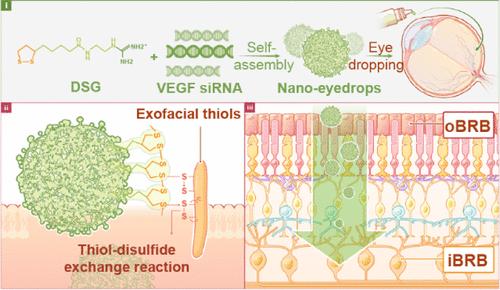Disulfide-Appended siRNA Nanoeyedrops: Noninvasive Gene Therapy for Targeting Retinal Angiogenesis
IF 16
1区 材料科学
Q1 CHEMISTRY, MULTIDISCIPLINARY
引用次数: 0
Abstract
Given the significant advantages the eye presents as a target organ for gene therapy, it has remained at the forefront of translational research in this field. However, gene delivery to the desired tissue, particularly the retina, via a noninvasive route of administration poses a substantial physical challenge due to the presence of multiple ocular barriers. Here, we develop disulfide-appended small interfering RNA (DS-siRNA) Nanoeyedrops that target pathological retinal angiogenesis. These Nanoeyedrops enable noninvasive and effective gene delivery into the retina through the thiol-mediated uptake route. We have demonstrated that the thiol-mediated uptake route represents a powerful approach capable of overcoming ocular barriers. Ultimately, we have applied these Nanoeyedrops to deliver VEGF siRNA, which has exhibited substantial effects in both choroidal neovascularization and retinoblastoma mouse models. It serves as a highly efficient delivery system that enables noninvasive ocular gene delivery with high bioavailability, thereby offering a promising strategy for treating retinal diseases.

二硫化物附加siRNA纳米滴眼液:针对视网膜血管生成的无创基因治疗
鉴于眼睛作为基因治疗的靶器官具有显著的优势,它一直处于该领域转化研究的前沿。然而,由于存在多重眼屏障,通过非侵入性给药途径将基因传递到所需组织,特别是视网膜,会带来实质性的物理挑战。在这里,我们开发了二硫化物附加的小干扰RNA (DS-siRNA)纳米滴眼液,用于病理视网膜血管生成。这些纳米滴眼液通过巯基介导的摄取途径使基因无创有效地进入视网膜。我们已经证明,巯基介导的摄取途径是一种强大的方法,能够克服眼屏障。最终,我们已经应用这些纳米滴眼液来递送VEGF siRNA,这在脉络膜新生血管和视网膜母细胞瘤小鼠模型中都显示出实质性的效果。它是一种高效的传递系统,可以实现高生物利用度的无创眼部基因传递,从而为治疗视网膜疾病提供了一种很有前途的策略。
本文章由计算机程序翻译,如有差异,请以英文原文为准。
求助全文
约1分钟内获得全文
求助全文
来源期刊

ACS Nano
工程技术-材料科学:综合
CiteScore
26.00
自引率
4.10%
发文量
1627
审稿时长
1.7 months
期刊介绍:
ACS Nano, published monthly, serves as an international forum for comprehensive articles on nanoscience and nanotechnology research at the intersections of chemistry, biology, materials science, physics, and engineering. The journal fosters communication among scientists in these communities, facilitating collaboration, new research opportunities, and advancements through discoveries. ACS Nano covers synthesis, assembly, characterization, theory, and simulation of nanostructures, nanobiotechnology, nanofabrication, methods and tools for nanoscience and nanotechnology, and self- and directed-assembly. Alongside original research articles, it offers thorough reviews, perspectives on cutting-edge research, and discussions envisioning the future of nanoscience and nanotechnology.
 求助内容:
求助内容: 应助结果提醒方式:
应助结果提醒方式:


